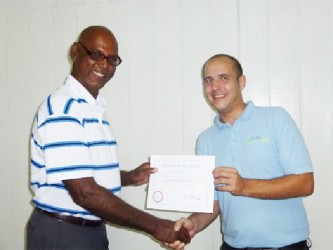Humberto Hamilton has been contemplating the unfolding developments in the country’s rice industry with a mixture of anxiety and optimism.
His concerns range from the likely implications of an unfolding freefall in the world market price for oil and its implications for Venezuela’s ability to sustain the PetroCaribe agreement that provides a market for around a third of the country’s overall rice production, to the pressures that will fall on the rice sector to replace the Venezuela market if the PetroCaribe deal threatens to fold.
Hamilton is a second-generation rice farmer. He inherited the pursuit from his parents, and is now in his thirtieth year of going it alone. He cultivates his crop on a 40-acre plot at Number Forty Village, West Coast Berbice.

Recent news that government has made available significant sums of money to enable millers to discharge what, in many instances, are long-outstanding liabilities to farmers for paddy has lifted his spirits. The farmers, he says, are in a pretty difficult position, powerless to do anything else but wait while their debts grow and their creditors grow more concerned. “Millers are united,” he says. “Sometimes it appears as though they are not in competition.”
He talks about his own experience in selling paddy. “You try to sell to all of the millers and you look for the best deals. Some millers pay promptly. With others there are times when you have to wait the duration of an entire crop to get paid. It’s tough when you have a family that you need to fend for and rice farmers are family men.”
He is concerned that finding markets will be one of the main challenges in the period ahead. “You get a sense that that paddy is just bunkering up; that it5 is going nowhere. There is so much more rice to sell these days. Three years ago rice production was just around 336,000 tonnes. At the end of 2014 it was 600,000 tonnes.”
Hamilton says the industry is in need of more mills and silos to take account of the increased production. “Some mills that are out of compliance need to be brought back,” he says.
Asked about the recently expressed view that Guyana may be reducing its dependence on the Venezuelan market he assumes an expression that resembles shock. Wearing what seems to be a permanent smile on his face he points out that the tonnage of rice and paddy exported to Venezuela was 250,000 tonnes annually. “Somebody will have to say where that amount of rice will be sold on a global market that is already trying to sell so much rice As far as he is concerned the immediate-term fortunes of the rice sector will depend to a considerable extent on decisions that have to be made in Caracas.
“Frankly, there have been improvements in the sector in recent years. There have been improved varieties of rice and enhanced drainage and irrigation facilities and there is cheaper fertilizer available in Venezuela. But more needs to be done. We have problems associated with “red rice” infestation that affects yield per acre.
The industry, Hamilton says, is not the bed of roses that it is sometimes made out to be. “It could cost up to $60,000 to cultivate an acre of rice. Two years ago the price of paddy was at around $2,000 per bag. These days we get about five hundred dollars more despite the fact that there have since been significant increases in harvesting and transportation costs,” he said
Hamilton believes that over the years the changing fortunes of the rice industry have reduced rice farmers to the status of gamblers. “Everything has some uncertainty attached to it. The global increase in rice production has made it worse. Rice harder to sell,” he said.
Hamilton is reluctant to paint a picture of doom and gloom. He talks up his current spring crop and says that while he has no intention of quitting the rice sector he is beginning to become attracted to the local coconut industry.
He returns to the theme of farmers who remain unpaid for paddy delivered to millers. “It’s a bad situation,” he says. “These farmers have loans to repay and there are other debts for other services that allow them to invest properly in the sector. If you buy fertilizer cash you pay $5,000 per bag. If you take it on credit it will cost you $6,000. That is the price you pay for not being paid on time. Sometimes it leaves the farmers in millions of dollars in debts.”




